Ethics and Profession: Analyzing IT Professional Issues - Case Studies
VerifiedAdded on 2020/03/02
|6
|1225
|61
Case Study
AI Summary
This assignment is a case study on ethics and professionalism within the field of Information Technology. It includes analysis of two case studies. The first case study explores ethical considerations in usability testing, focusing on consent forms and the role of the ICT department in balancing participant satisfaction and testing goals. The second case study analyzes a persuasive speech, identifying techniques like colloquialism and pathos. The assignment also addresses procrastination, differentiating it from forgetting and discusses self-management and leadership, referencing a lecture on the hierarchy of needs, scheduling, and stress management. The student reflects on the lecture's concepts, discussing evaluation, planning, and steps to improve self-management. References include the Australian Computer Society's Code of Professional Conduct, lecture materials, and resources on linguistic devices.
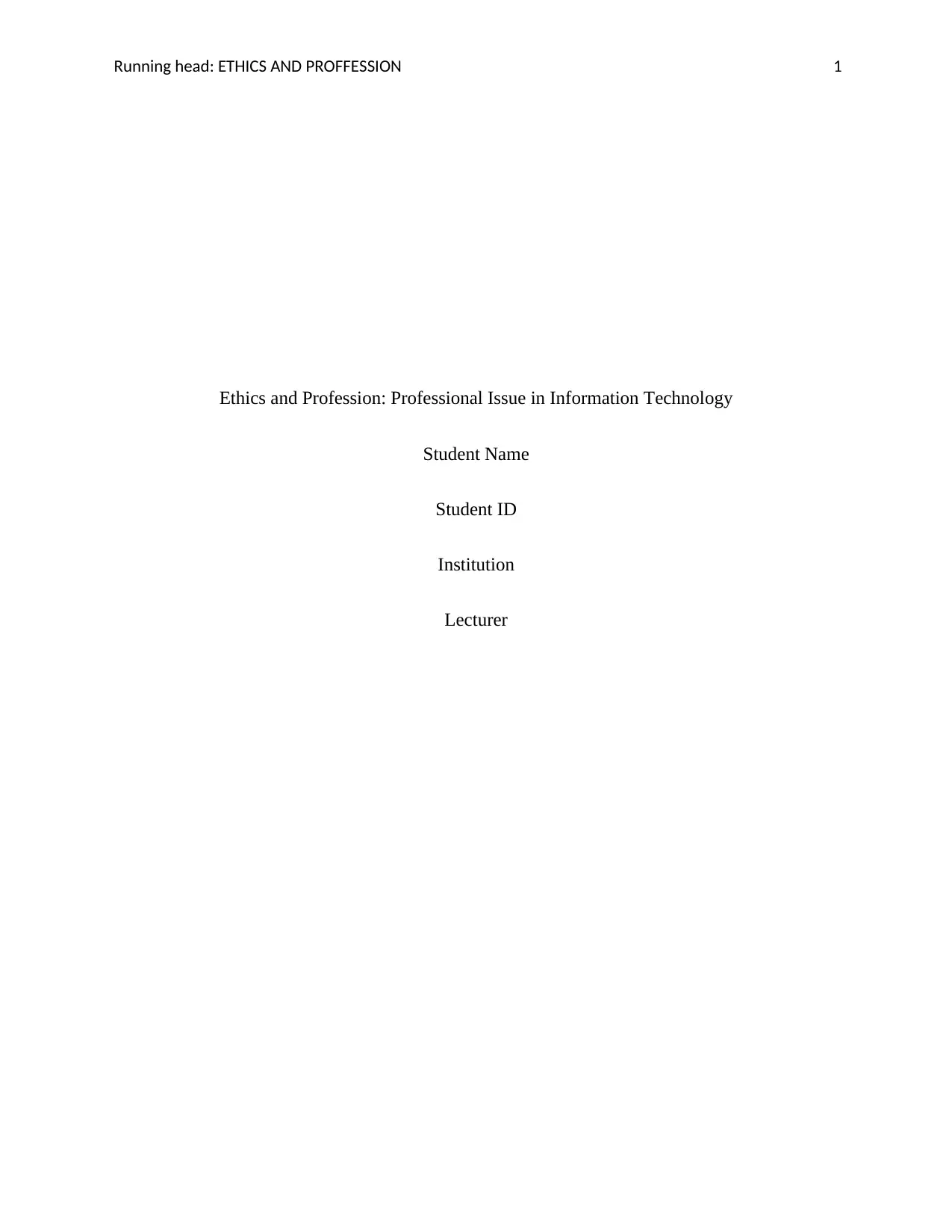
Running head: ETHICS AND PROFFESSION 1
Ethics and Profession: Professional Issue in Information Technology
Student Name
Student ID
Institution
Lecturer
Ethics and Profession: Professional Issue in Information Technology
Student Name
Student ID
Institution
Lecturer
Paraphrase This Document
Need a fresh take? Get an instant paraphrase of this document with our AI Paraphraser
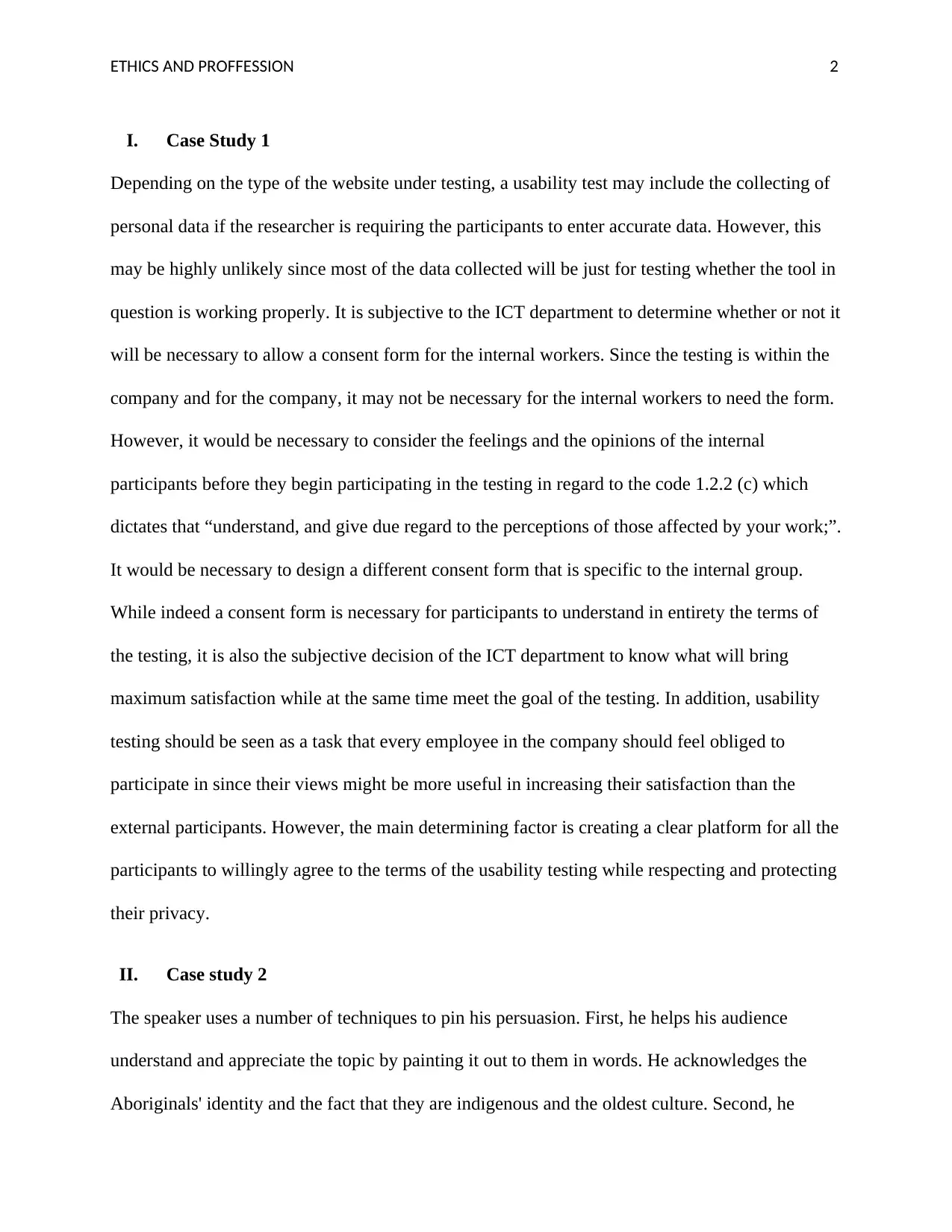
ETHICS AND PROFFESSION 2
I. Case Study 1
Depending on the type of the website under testing, a usability test may include the collecting of
personal data if the researcher is requiring the participants to enter accurate data. However, this
may be highly unlikely since most of the data collected will be just for testing whether the tool in
question is working properly. It is subjective to the ICT department to determine whether or not it
will be necessary to allow a consent form for the internal workers. Since the testing is within the
company and for the company, it may not be necessary for the internal workers to need the form.
However, it would be necessary to consider the feelings and the opinions of the internal
participants before they begin participating in the testing in regard to the code 1.2.2 (c) which
dictates that “understand, and give due regard to the perceptions of those affected by your work;”.
It would be necessary to design a different consent form that is specific to the internal group.
While indeed a consent form is necessary for participants to understand in entirety the terms of
the testing, it is also the subjective decision of the ICT department to know what will bring
maximum satisfaction while at the same time meet the goal of the testing. In addition, usability
testing should be seen as a task that every employee in the company should feel obliged to
participate in since their views might be more useful in increasing their satisfaction than the
external participants. However, the main determining factor is creating a clear platform for all the
participants to willingly agree to the terms of the usability testing while respecting and protecting
their privacy.
II. Case study 2
The speaker uses a number of techniques to pin his persuasion. First, he helps his audience
understand and appreciate the topic by painting it out to them in words. He acknowledges the
Aboriginals' identity and the fact that they are indigenous and the oldest culture. Second, he
I. Case Study 1
Depending on the type of the website under testing, a usability test may include the collecting of
personal data if the researcher is requiring the participants to enter accurate data. However, this
may be highly unlikely since most of the data collected will be just for testing whether the tool in
question is working properly. It is subjective to the ICT department to determine whether or not it
will be necessary to allow a consent form for the internal workers. Since the testing is within the
company and for the company, it may not be necessary for the internal workers to need the form.
However, it would be necessary to consider the feelings and the opinions of the internal
participants before they begin participating in the testing in regard to the code 1.2.2 (c) which
dictates that “understand, and give due regard to the perceptions of those affected by your work;”.
It would be necessary to design a different consent form that is specific to the internal group.
While indeed a consent form is necessary for participants to understand in entirety the terms of
the testing, it is also the subjective decision of the ICT department to know what will bring
maximum satisfaction while at the same time meet the goal of the testing. In addition, usability
testing should be seen as a task that every employee in the company should feel obliged to
participate in since their views might be more useful in increasing their satisfaction than the
external participants. However, the main determining factor is creating a clear platform for all the
participants to willingly agree to the terms of the usability testing while respecting and protecting
their privacy.
II. Case study 2
The speaker uses a number of techniques to pin his persuasion. First, he helps his audience
understand and appreciate the topic by painting it out to them in words. He acknowledges the
Aboriginals' identity and the fact that they are indigenous and the oldest culture. Second, he
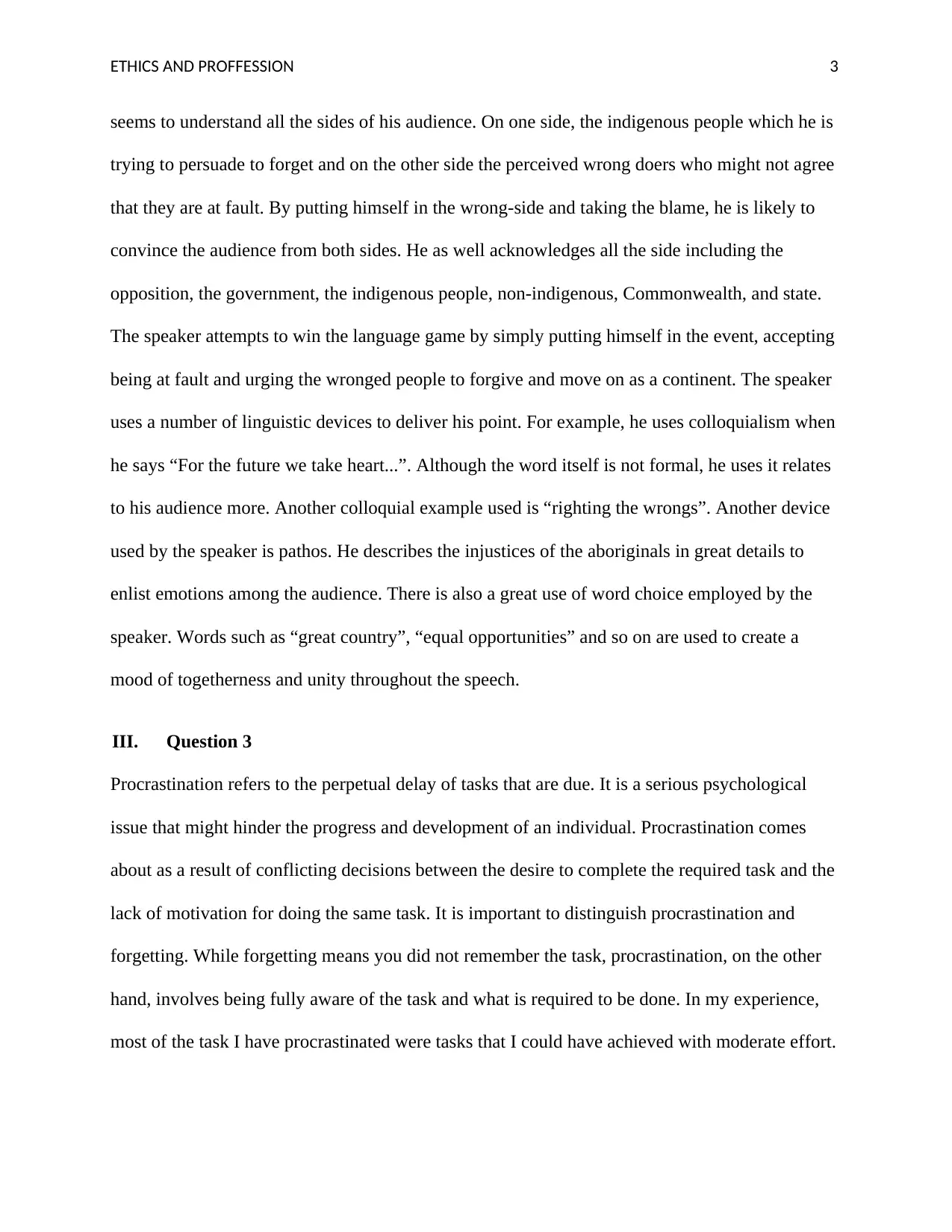
ETHICS AND PROFFESSION 3
seems to understand all the sides of his audience. On one side, the indigenous people which he is
trying to persuade to forget and on the other side the perceived wrong doers who might not agree
that they are at fault. By putting himself in the wrong-side and taking the blame, he is likely to
convince the audience from both sides. He as well acknowledges all the side including the
opposition, the government, the indigenous people, non-indigenous, Commonwealth, and state.
The speaker attempts to win the language game by simply putting himself in the event, accepting
being at fault and urging the wronged people to forgive and move on as a continent. The speaker
uses a number of linguistic devices to deliver his point. For example, he uses colloquialism when
he says “For the future we take heart...”. Although the word itself is not formal, he uses it relates
to his audience more. Another colloquial example used is “righting the wrongs”. Another device
used by the speaker is pathos. He describes the injustices of the aboriginals in great details to
enlist emotions among the audience. There is also a great use of word choice employed by the
speaker. Words such as “great country”, “equal opportunities” and so on are used to create a
mood of togetherness and unity throughout the speech.
III. Question 3
Procrastination refers to the perpetual delay of tasks that are due. It is a serious psychological
issue that might hinder the progress and development of an individual. Procrastination comes
about as a result of conflicting decisions between the desire to complete the required task and the
lack of motivation for doing the same task. It is important to distinguish procrastination and
forgetting. While forgetting means you did not remember the task, procrastination, on the other
hand, involves being fully aware of the task and what is required to be done. In my experience,
most of the task I have procrastinated were tasks that I could have achieved with moderate effort.
seems to understand all the sides of his audience. On one side, the indigenous people which he is
trying to persuade to forget and on the other side the perceived wrong doers who might not agree
that they are at fault. By putting himself in the wrong-side and taking the blame, he is likely to
convince the audience from both sides. He as well acknowledges all the side including the
opposition, the government, the indigenous people, non-indigenous, Commonwealth, and state.
The speaker attempts to win the language game by simply putting himself in the event, accepting
being at fault and urging the wronged people to forgive and move on as a continent. The speaker
uses a number of linguistic devices to deliver his point. For example, he uses colloquialism when
he says “For the future we take heart...”. Although the word itself is not formal, he uses it relates
to his audience more. Another colloquial example used is “righting the wrongs”. Another device
used by the speaker is pathos. He describes the injustices of the aboriginals in great details to
enlist emotions among the audience. There is also a great use of word choice employed by the
speaker. Words such as “great country”, “equal opportunities” and so on are used to create a
mood of togetherness and unity throughout the speech.
III. Question 3
Procrastination refers to the perpetual delay of tasks that are due. It is a serious psychological
issue that might hinder the progress and development of an individual. Procrastination comes
about as a result of conflicting decisions between the desire to complete the required task and the
lack of motivation for doing the same task. It is important to distinguish procrastination and
forgetting. While forgetting means you did not remember the task, procrastination, on the other
hand, involves being fully aware of the task and what is required to be done. In my experience,
most of the task I have procrastinated were tasks that I could have achieved with moderate effort.
⊘ This is a preview!⊘
Do you want full access?
Subscribe today to unlock all pages.

Trusted by 1+ million students worldwide
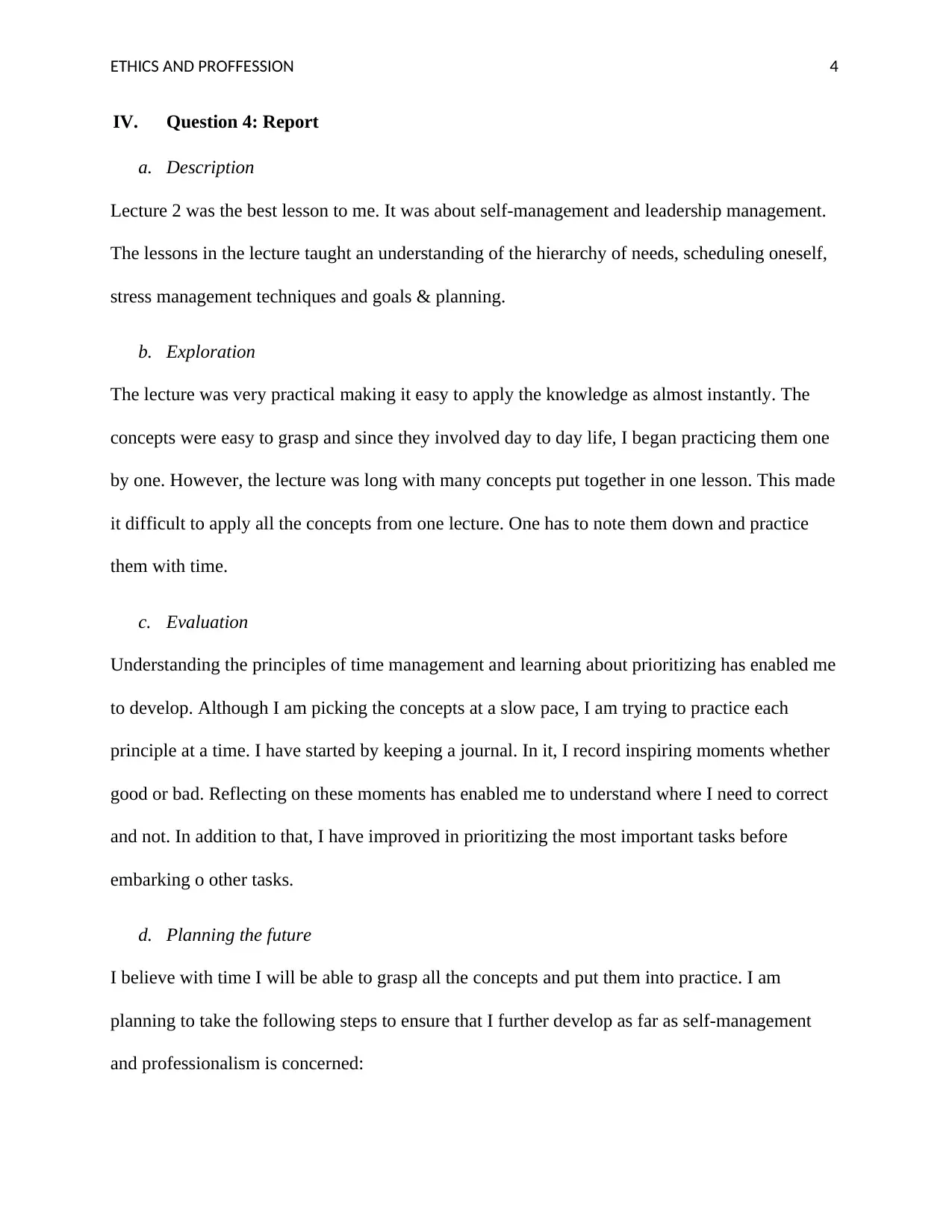
ETHICS AND PROFFESSION 4
IV. Question 4: Report
a. Description
Lecture 2 was the best lesson to me. It was about self-management and leadership management.
The lessons in the lecture taught an understanding of the hierarchy of needs, scheduling oneself,
stress management techniques and goals & planning.
b. Exploration
The lecture was very practical making it easy to apply the knowledge as almost instantly. The
concepts were easy to grasp and since they involved day to day life, I began practicing them one
by one. However, the lecture was long with many concepts put together in one lesson. This made
it difficult to apply all the concepts from one lecture. One has to note them down and practice
them with time.
c. Evaluation
Understanding the principles of time management and learning about prioritizing has enabled me
to develop. Although I am picking the concepts at a slow pace, I am trying to practice each
principle at a time. I have started by keeping a journal. In it, I record inspiring moments whether
good or bad. Reflecting on these moments has enabled me to understand where I need to correct
and not. In addition to that, I have improved in prioritizing the most important tasks before
embarking o other tasks.
d. Planning the future
I believe with time I will be able to grasp all the concepts and put them into practice. I am
planning to take the following steps to ensure that I further develop as far as self-management
and professionalism is concerned:
IV. Question 4: Report
a. Description
Lecture 2 was the best lesson to me. It was about self-management and leadership management.
The lessons in the lecture taught an understanding of the hierarchy of needs, scheduling oneself,
stress management techniques and goals & planning.
b. Exploration
The lecture was very practical making it easy to apply the knowledge as almost instantly. The
concepts were easy to grasp and since they involved day to day life, I began practicing them one
by one. However, the lecture was long with many concepts put together in one lesson. This made
it difficult to apply all the concepts from one lecture. One has to note them down and practice
them with time.
c. Evaluation
Understanding the principles of time management and learning about prioritizing has enabled me
to develop. Although I am picking the concepts at a slow pace, I am trying to practice each
principle at a time. I have started by keeping a journal. In it, I record inspiring moments whether
good or bad. Reflecting on these moments has enabled me to understand where I need to correct
and not. In addition to that, I have improved in prioritizing the most important tasks before
embarking o other tasks.
d. Planning the future
I believe with time I will be able to grasp all the concepts and put them into practice. I am
planning to take the following steps to ensure that I further develop as far as self-management
and professionalism is concerned:
Paraphrase This Document
Need a fresh take? Get an instant paraphrase of this document with our AI Paraphraser

ETHICS AND PROFFESSION 5
1. Keep an active diary to note daily tasks before going to sleep. This will allow me to plan
my day prior.
2. Prioritize my long term and short term goals and have them written down in a notebook.
This will be important to ensure I keep myself on track.
3. Note all significant memories down. Reading about what I have done through the day will
help identify what I need to improve on.
4. Have a yearly planner with my school time table included. With a yearly planner, I will be
able to know what will be due in time and be able to plan my time well.
1. Keep an active diary to note daily tasks before going to sleep. This will allow me to plan
my day prior.
2. Prioritize my long term and short term goals and have them written down in a notebook.
This will be important to ensure I keep myself on track.
3. Note all significant memories down. Reading about what I have done through the day will
help identify what I need to improve on.
4. Have a yearly planner with my school time table included. With a yearly planner, I will be
able to know what will be due in time and be able to plan my time well.
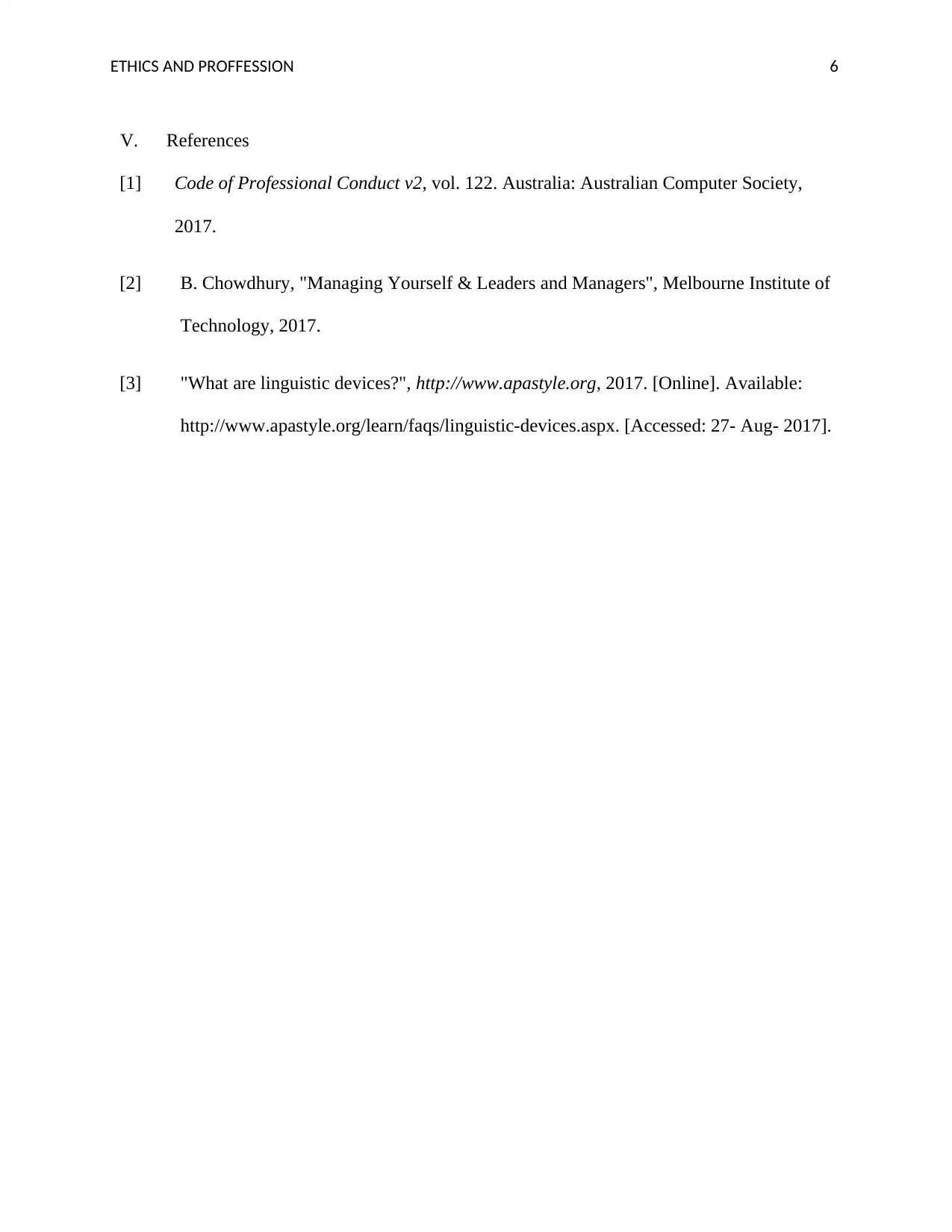
ETHICS AND PROFFESSION 6
V. References
[1] Code of Professional Conduct v2, vol. 122. Australia: Australian Computer Society,
2017.
[2] B. Chowdhury, "Managing Yourself & Leaders and Managers", Melbourne Institute of
Technology, 2017.
[3] "What are linguistic devices?", http://www.apastyle.org, 2017. [Online]. Available:
http://www.apastyle.org/learn/faqs/linguistic-devices.aspx. [Accessed: 27- Aug- 2017].
V. References
[1] Code of Professional Conduct v2, vol. 122. Australia: Australian Computer Society,
2017.
[2] B. Chowdhury, "Managing Yourself & Leaders and Managers", Melbourne Institute of
Technology, 2017.
[3] "What are linguistic devices?", http://www.apastyle.org, 2017. [Online]. Available:
http://www.apastyle.org/learn/faqs/linguistic-devices.aspx. [Accessed: 27- Aug- 2017].
⊘ This is a preview!⊘
Do you want full access?
Subscribe today to unlock all pages.

Trusted by 1+ million students worldwide
1 out of 6
Your All-in-One AI-Powered Toolkit for Academic Success.
+13062052269
info@desklib.com
Available 24*7 on WhatsApp / Email
![[object Object]](/_next/static/media/star-bottom.7253800d.svg)
Unlock your academic potential
Copyright © 2020–2025 A2Z Services. All Rights Reserved. Developed and managed by ZUCOL.


